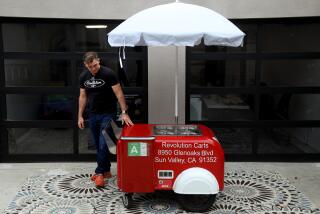Extending the reach of farmers markets
Farmers markets have changed modern American cooking and dining more than any other single factor. They’ve opened up a new world of ingredients for chefs and cooks, and they’ve allowed farmers to be rewarded for growing fruits and vegetables with superior quality.
But as wonderful as they are, farmers markets — open only for a couple of hours on certain days in certain locations — are about as inconvenient as they could possibly be.
If the movement to bring more high-quality ingredients to more people is to continue to grow, we’re going to need to find alternatives. These will not be replacements for farmers markets but supplements to extend their reach.
Here are a few ideas that have merit. Some, such as community-supported agriculture (CSA) programs, are already happening; others are still percolating.
Delivery services: If you can’t come to the market, why not have the market come to you? Order your farmers market produce online and have a delivery service bring it to your home or office. Good Eggs is already making a start in Southern California.
Bricks and mortar: Even though farmers markets started at least in part as alternatives to grocery stores, what would be wrong with having a store where you could buy produce grown by local farmers? Whole Foods is already spending millions of dollars to teach local suppliers how to work within a giant chain. But it may well work best on a smaller scale, the way downtown’s Urban Radish market and restaurant searches out great ingredients and offers them for sale.
Permanent markets: Today, most farmers markets are extremely temporary — trestle tables and tarps. A permanent structure could allow some farmers to attend more than once a week. It could also double as a center for other community activities. In Davis, the farmers market shelter also serves as a concert space during the summer.
Workplace CSAs: Since many of us spend eight to 10 hours a day at our workplaces, wouldn’t it make sense to base CSAs there? Might it not fit in to a workplace health initiative?
Affordability: High-quality produce grown by small farmers will almost inevitably be more expensive than that grown in massive quantities on sprawling acreage. So, markets should pursue programs like those that double the value of SNAP vouchers (food stamps) when spent on their fresh produce.
Convenient shopping: So far, most farmers markets have been located where city planners want shoppers to go, rather than putting them were shoppers already are. What about placing farmers markets at major transportation points for buses and light rail or at major workplaces? Kaiser Permanente already hosts farmers markets at more than a dozen Southern California medical centers.
Produce trucks: In many neighborhoods, there are periodic visits from big white step-vans from which merchants sell cheap produce. Why couldn’t someone do the same with high-quality fruits and vegetables from farmers markets? It’s certainly worked with chef-driven food trucks.
More to Read
Eat your way across L.A.
Get our weekly Tasting Notes newsletter for reviews, news and more.
You may occasionally receive promotional content from the Los Angeles Times.











